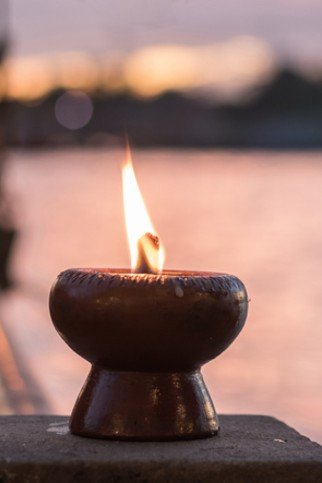Cremation Services
Cremation is an alternative to casket burial and it is chosen by many people because of religious beliefs, the desire to preserve the environment or it was requested by the person who died. Cremation is also generally a less expensive option in comparison to a casket burial. The remains are placed in a container that is combustible and placed in a special furnace called a cremation chamber or a crematory where through intense heat it is reduced to bone fragments that are then processed to resemble course sand. The cremated remains of an average adult body will weigh about 7-8 pounds. Cremation is not an alternative to a funeral, but rather an alternative to burial or other forms of final disposition.
Cremated remains can be scattered or buried, or they may be kept with the family in a decorative urn. There are many new and different ways to disperse ashes today, cremated remains can be placed in an artificial coral reef in the ocean, they can be launched into space or sent up in helium balloons, or they can be spun into glass pieces of art or compressed into beautiful man-made diamonds.
Cremation FAQ
What is Cremation?
Cremation is the process of reducing the human body to bone fragments using high heat and flame. Cremation is not the final disposition of the remains, nor is it a type of funeral service.
Is a casket needed for Cremation?
No, a casket is not required, although most provinces require an alternative container constructed of wood or cardboard.
Is embalming required prior to cremation?
No. In fact it is against the law for a funeral home to tell you otherwise.
Can the body be viewed without embalming?
Yes, it may be possible for the family to view the remains prior to cremation without embalming, though it is best to discuss this with your funeral director.
Can the family witness the cremation?
No, family may not view the cremation. There may be exceptions when this is part of a cultural or religious tradition. Not every crematorium is equipped to accomodate this request.
Can an urn be brought into church?
Yes.
What can be done with the remains?
While laws vary by province, for the most part remains can be buried in a cemetery lot or a cremation garden, interred in a columbarium, kept at home or scattered.
How can I be sure I receive the correct remains?
All reputable cremation providers have developed rigorous sets of operating policies and procedures in order to maximize the level of service and minimize the potential for human error. Since it is illegal to perform more than one cremation at a time, and the vast majority of crematories can only cremate one body at a time, it is next to impossible to receive the incorrect remains.
How long does the actual cremation take?
It all depends on the weight of the individual. For an average sized adult, cremation can take two to three hours at a normal operating temperature of between 1,000 and 2,000 degrees Fahrenheit.
What do the cremated remains look like?
Cremated remains resemble coarse sand and are whitish to light grey in color. The remains of an average sized adult usually weighs between 7 and 8 pounds.
Are all the cremated remains returned?
With the exception of minute and microscopic particles, which are impossible to remove from the cremation chamber and processing machine, all of the cremated remains are given back to the family.
Do I need an urn?
An urn is not required by law. However, an urn may be desired if there is to be a memorial service or if the remains are to be interred in a cemetery. If an urn is not purchased or provided by the family, the cremated remains will be returned in a temporary cardboard container.









